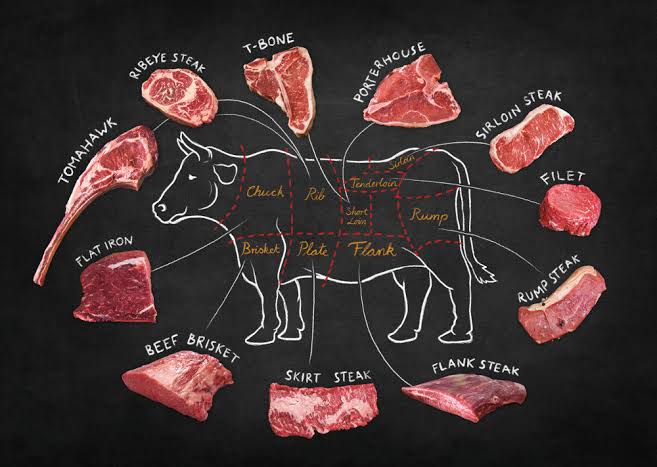Meat Cut Comparison Chart: A Butcher’s Guide to Understanding Beef, Lamb, Pork and Chicken Cuts
Introduction
When it comes to getting the most flavour, value, and performance from your meat, knowing your cuts makes all the difference. Whether you're a professional chef sourcing meat for a busy kitchen, or a home cook looking to elevate your next Sunday roast, understanding where each cut comes from—and how to cook it—can help you get the best out of every piece.
At University Meat, we know that not all cuts are created equal. Some are prized for their tenderness and quick cooking times, while others shine after hours in the slow cooker. Choosing the right cut isn’t just about cost—it’s about matching the meat to the method.
In this guide, we’ve created a detailed Meat Cut Comparison Chart to help you make informed choices across beef, lamb, pork and chicken. Whether you’re planning a menu, shopping in bulk, or simply looking to improve your cooking skills, this butcher’s guide will give you the knowledge you need to cook with confidence.
Beef Cuts Explained
Beef is one of the most versatile and popular meats in Australian kitchens, but with so many different cuts available, it can be tricky to know which one suits your needs. From premium steaks to slow-cooked roasts, each cut has its own texture, flavour profile and ideal cooking method.
Below is an overview of the main primal cuts of beef and how they’re commonly used.
- Chuck
- Location: Shoulder area
- Texture: Flavourful and well-marbled, but tougher
- Best for: Slow-cooking, casseroles, stews, mince
- Notes: Chuck is budget-friendly and becomes tender when cooked low and slow.
2. Rib
- Location: Upper rib section
- Texture: Rich and tender with good marbling
- Best for: Ribeye steaks, prime rib roasts, BBQ
- Notes: High in flavour—ideal for special occasions or restaurant-quality meals.
3. Loin
- Location: Behind the ribs, along the spine
- Texture: Very tender and lean
- Best for: Porterhouse, T-bone, sirloin, tenderloin
- Notes: Premium steaks come from this section; excellent for grilling or pan-frying.
4. Rump
- Location: Hindquarter
- Texture: Firm but flavourful
- Best for: Steaks, stir-fries, roasting
- Notes: Great all-rounder; offers good value for money and suits a range of dishes.
5. Brisket
- Location: Lower chest
- Texture: Tough but full of connective tissue
- Best for: Smoking, slow roasting, braising
- Notes: Needs time but rewards with deep flavour and pull-apart tenderness.
6. Flank
- Location: Lower abdominal muscles
- Texture: Lean and fibrous
- Best for: Stir-fries, fajitas, marinated grilling
- Notes: Best sliced against the grain; often underrated but delicious when prepped well.
7. Round (or Silverside/Topside)
- Location: Back leg
- Texture: Lean and moderately tough
- Best for: Roasting, corned beef, schnitzel
- Notes: Economical cut; often used for cold cuts or family roasts.
Lamb Cuts Explained
Lamb is a staple in many Australian households and restaurant kitchens, known for its rich flavour and tender texture. As with beef, different cuts lend themselves to different cooking techniques—some are perfect for slow roasting, while others are better suited to quick grilling or pan-frying.
Understanding the key lamb cuts can help you select the right piece for your dish, whether you're serving up a Sunday roast or prepping for a café lunch menu. Below, we break down the primary cuts of lamb and how best to use them.
1. Leg
- Location: Hind leg
- Texture: Lean and tender with a small fat cap
- Best for: Roasting, butterflied and grilled, diced for curries
- Notes: A crowd favourite—perfect for traditional roast lamb or large gatherings.
2. Loin
- Location: Along the back between the ribs and hindquarters
- Texture: Very tender and fine-grained
- Best for: Loin chops, lamb noisettes, quick pan-frying or grilling
- Notes: A premium cut—great for elegant, quick-cooking meals.
3. Shoulder
- Location: Front leg and shoulder
- Texture: Flavourful and fatty, with connective tissue
- Best for: Slow roasting, braising, pulled lamb
- Notes: Requires longer cooking time but delivers intense flavour and tenderness.
4. Rack
- Location: Upper rib section (between shoulder and loin)
- Texture: Tender and fine-grained
- Best for: French-trimmed racks, cutlets, roasting
- Notes: A premium cut often seen in restaurants—impressive and delicious.
5. Forequarter
- Location: Front half of the lamb, including shoulder and part of the rib
- Texture: Mixed – some tender, some requiring slow cooking
- Best for: Chops, slow roasts, stews
- Notes: Offers a range of cuts that are economical and full of flavour.
6. Shanks
- Location: Lower part of the front or back legs
- Texture: Very tough initially, becomes fall-apart tender when braised
- Best for: Slow braises, soups, winter comfort meals
- Notes: A popular winter cut that’s rich, hearty and ideal for slow cooking.
Image Courtesy of The Spruce Eats
Pork Cuts Explained
Pork offers incredible versatility—from succulent roasts to crispy crackling and flavour-packed slow-cooked dishes. Choosing the right pork cut can elevate your cooking, helping you balance tenderness, flavour and value.
Here’s a breakdown of the primary pork cuts, how they’re typically used, and what to look for when buying.
1. Shoulder (Boston Butt & Picnic)
- Location: Upper front leg and shoulder
- Texture: Marbled with fat and connective tissue; rich in flavour
- Best for: Slow roasting, pulled pork, sausages
- Notes: A great value cut—ideal for low-and-slow recipes where fat renders into juicy, tender meat.
2. Loin
- Location: Runs along the back, between shoulder and leg
- Texture: Lean and tender
- Best for: Loin chops, pork roast, schnitzels, medallions
- Notes: Popular for its tenderness; avoid overcooking to retain moisture.
3. Belly
- Location: Underside of the pig, behind the ribs
- Texture: High in fat with alternating layers of meat
- Best for: Crackling roast, slow-braised pork, bacon
- Notes: Known for its richness—can be crisped up or slow-cooked for melt-in-your-mouth results.
4. Leg
- Location: Back legs
- Texture: Lean and slightly firm
- Best for: Roasting, hams, schnitzels
- Notes: Makes an impressive roast; often cured or smoked into ham.
5. Ribs (Spare Ribs & Baby Back)
- Location: Ribcage, between shoulder and loin
- Texture: Marbled with fat, chewy but flavourful
- Best for: BBQ, smoking, roasting
- Notes: A BBQ favourite—ribs are best slow-cooked or smoked to tenderness.
6. Hock
- Location: Lower part of the leg (below shoulder or leg)
- Texture: Tough with skin and connective tissue
- Best for: Soups, slow braises, flavouring stock
- Notes: Underrated but flavour-packed—great in hearty dishes.
Image Courtesy of WebstaurantStore
Chicken Cuts Explained
Chicken is a staple protein in both commercial kitchens and Aussie homes—loved for its versatility, affordability and broad appeal. While it’s often sold whole, understanding individual chicken cuts can help you choose the right option for your recipe, budget and prep time.
Here’s a guide to the main chicken cuts available from your butcher and what each is best used for.
1. Whole Chicken
- Description: Entire bird, usually cleaned and ready to roast or break down
- Best for: Roasting, poaching, breaking down into parts
- Notes: Buying whole is often more economical and allows for use of bones in stocks.
2. Breast
- Location: Front of the bird, either skin-on or skinless
- Texture: Lean, tender and mild in flavour
- Best for: Grilling, pan-frying, stir-fries, schnitzel
- Notes: Quick to cook but can dry out—best with marinades or moist cooking methods.
3. Thigh
- Location: Upper leg, sold bone-in or boneless
- Texture: Juicy and more flavourful than breast
- Best for: Curries, slow-cooking, BBQ, oven baking
- Notes: Great for dishes needing bold flavour and forgiving with cooking times.
4. Drumstick
- Location: Lower part of the leg
- Texture: Firm and juicy with skin and bone
- Best for: Roasting, grilling, slow cooking
- Notes: Affordable and kid-friendly—works well with bold marinades.
5. Wing
- Location: Attached to the breast, includes drumette, wingette and tip
- Texture: Skin-on, small amount of meat
- Best for: Deep frying, BBQ, oven baking
- Notes: Popular for finger food—crispy skin and bold seasoning work best.
6. Marylands
- Location: Whole leg (thigh and drumstick combined)
- Texture: Tender and juicy
- Best for: Roasting, braising, tray bakes
- Notes: Perfect for one-pan meals and holds flavour well.
Visual Meat Cut Comparison Table
To make choosing the right cut easier, we’ve pulled together a side-by-side comparison of beef, lamb, pork and chicken cuts. This chart includes location, texture, best uses and value rating, helping you make smart decisions whether you're ordering in bulk or cooking for the family.
|
Meat Type |
Cut |
Location |
Texture |
Best For |
Value Rating |
|
Beef |
Chuck |
Shoulder |
Tough, well-marbled |
Slow cooking, stews |
★★★★☆ |
|
Rib |
Upper ribs |
Tender, marbled |
Grilling, roasting |
★★★☆☆ |
|
|
Loin |
Mid-back |
Very tender |
Premium steaks |
★★☆☆☆ |
|
|
Rump |
Hindquarter |
Firm, flavourful |
Steaks, stir-fries |
★★★★☆ |
|
|
Brisket |
Chest |
Tough, collagen-rich |
Smoking, braising |
★★★★☆ |
|
|
Round |
Back leg |
Lean, slightly tough |
Roasting, schnitzel |
★★★★☆ |
|
|
Lamb |
Leg |
Hind leg |
Lean, tender |
Roasting, grilling |
★★★★☆ |
|
Loin |
Mid-back |
Very tender |
Chops, grilling |
★★☆☆☆ |
|
|
Shoulder |
Front leg/shoulder |
Flavourful, fatty |
Slow roasts, braising |
★★★★☆ |
|
|
Rack |
Upper rib section |
Tender, elegant |
Roasting, cutlets |
★★☆☆☆ |
|
|
Shanks |
Lower legs |
Tough, gelatinous |
Slow braising |
★★★★★ |
|
|
Pork |
Shoulder |
Front leg/shoulder |
Marbled, rich |
Pulled pork, sausages |
★★★★★ |
|
Loin |
Mid-back |
Lean, tender |
Chops, roasting |
★★★☆☆ |
|
|
Belly |
Underside |
Fatty, layered |
Slow roast, crackling |
★★★★☆ |
|
|
Leg |
Back leg |
Lean, firm |
Roasting, ham |
★★★★☆ |
|
|
Ribs |
Ribcage |
Flavourful, chewy |
BBQ, roasting |
★★★★☆ |
|
|
Chicken |
Breast |
Front of bird |
Lean, tender |
Grilling, stir-fries |
★★★☆☆ |
|
Thigh |
Upper leg |
Juicy, rich |
Curries, BBQ |
★★★★★ |
|
|
Drumstick |
Lower leg |
Firm, flavourful |
Oven baking, grilling |
★★★★☆ |
|
|
Wing |
Attached to breast |
Skin-on, less meat |
Finger food, deep frying |
★★★★☆ |
|
|
Maryland |
Whole leg |
Tender, juicy |
Tray bakes, braising |
★★★★★ |
⭐ Value Rating: Based on a combination of price, versatility, and flavour. ★★★★★ = exceptional value; ★☆☆☆☆ = premium cut with limited flexibility.
Conclusion: Choose the Right Cut Every Time
Whether you're a home cook planning a Sunday roast or a chef prepping for a busy lunch service, understanding meat cuts is key to getting the most value and flavour out of your ingredients. Each cut has its own strengths—some shine when cooked fast and hot, others reward you with unbeatable flavour when given time.
Our charts and guides are designed to make your meat selection easier, smarter and more cost-effective. With a little know-how, you’ll be cooking with more confidence and better results.
Need Help Choosing the Right Cut?
Our team at University Meat is here to help. Whether you're after bulk meat for your business or expert advice for a home recipe, we’ve got the experience and range to guide your decision.
Call us, or Shop online, or message us to explore our full selection of quality meats.
 © 2016 University Meat |
© 2016 University Meat |











